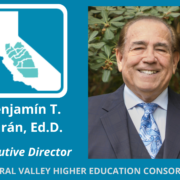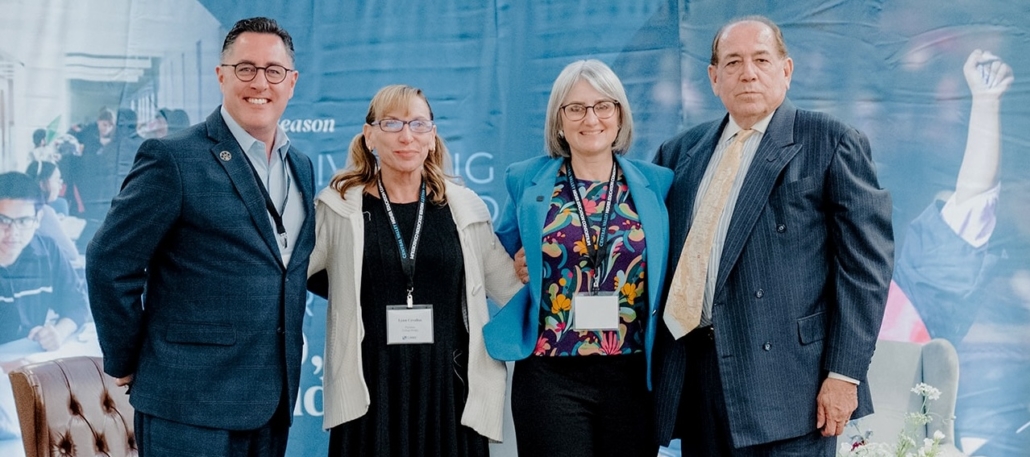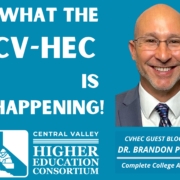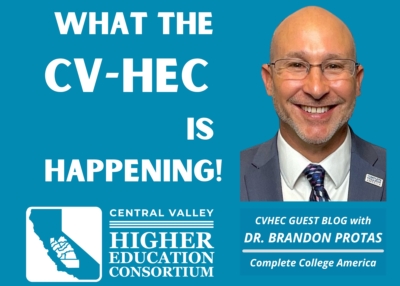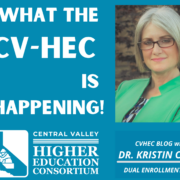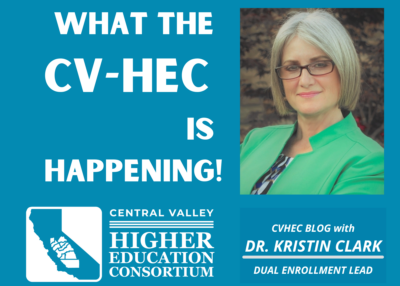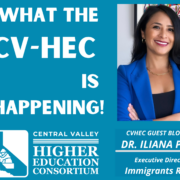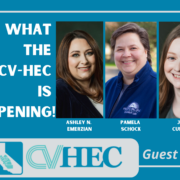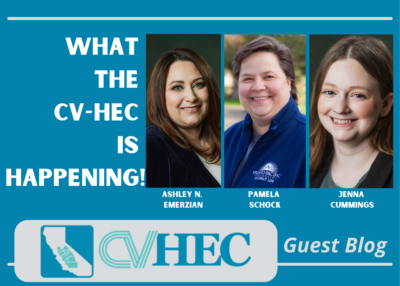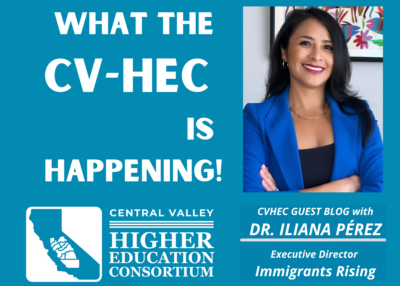
This edition of the “What the CV-HEC is Happening” Blog features Dr. Iliana Pérez, executive director of Immigrants Rising, a San Francisco-based nonprofit organization dedicated to advancing opportunities for undocumented communities. Founded in 2006, Immigrants Rising transforms individuals and fuels broader changes to help our nation edge closer to fulfilling its ideal as a land of opportunity and access for all. With resources and support, undocumented people are able to get an education, pursue careers and build a brighter future for themselves and their community. Dr. Pérez, who was raised in the Central Valley native (Turlock), is an alumna of CVHEC-member Fresno State Fresno State where she earned a BA in mathematics before attending Claremont University for her master’s in economics and her PhD in education policy, evaluation and reform. She and her organization have worked with several CVHEC-member campuses regarding issues related to undocumented students including an entrepreneurship incubator and pitch competition for undocumented students with a shark tank style competition planned at Fresno State later this semester. In this month’s blog, she shares her personal experience as an undocumented student who has reinvested herself in her community. She outlines gains and ongoing challenges in that landscape and resources regarding undocumented students available to institutions of higher education. CVHEC members interested in collaborating with Immigrants Rising for their undocumented students may contact Dr. Pérez at iliana@immigrantsrising.org. (Submissions are welcome for consideration: Tom Uribes, cvheccommunications@mail.fresnostate.edu).
Blazing a Trail: my journey as an undocumented student
and the path forward for higher education
BY DR. ILIANA PÉREZ
Executive Director, Immigrants Rising
Growing up undocumented in the United States, higher education often felt like an impossible dream. The barriers were daunting, and the path ahead was unclear. Yet, with resilience, the support of my family and community, and the guidance of dedicated educators, I navigated my way from being an undocumented student to ultimately becoming one of the first undocumented Ph.D.s in the nation.
Today, as the executive director of Immigrants Rising, I see both the incredible progress we have made and the challenges that still lie ahead for undocumented students in higher education. It is my pleasure to see many more undocumented students breaking barriers, knowing that our collective success is shaping a more inclusive and equitable future. It is your necessary presence that transforms higher education and your resilience that carves out a future where undocumented students are an integral part of higher education. Your dreams, contributions, and belonging will shape the future of education for generations to come.
A mentor once told me, “We can’t make big, bold changes by remaining the token person — we must push forward, bring others with us, and work toward systemic change.”
Many undocumented students on this journey today may be facing some critical questions: Do my contributions matter? Are my dreams valid? What legacy — what journey can there be for human beings like me with this uncertainty? Do I belong here? These are questions that loomed over me when I began my academic journey at Fresno State in 2005. Considerable progress has been made since then, but today, these questions resurface.
My academic journey was deeply shaped by my time at Fresno State, a proud member of Central Valley Higher Education Consortium. As an undergraduate, I experienced firsthand the power of a supportive institution — one that embraced students like me, who often had to carve our own paths when there were no clear policies and financial aid structures. Fortunately, I was able to secure a full-ride scholarship through the Smittcamp Family Honors College at Fresno State, which provided the financial stability I needed to focus on my studies. However, even with this scholarship, barriers remained. I was restricted from employment and paid career training opportunities and remained uncertain about my undocumented status. At the time, about 1,620 undocumented students enrolled in higher education faced significant hurdles: ineligibility for federal financial aid, limited access to scholarships, and the ever-present fear of being unable to continue our education due to policy changes beyond our control.
Despite these challenges, I found support in the form of mentors, allies, and advocacy efforts within Fresno State and beyond. AB 540, which allowed me to pay in-state tuition, was a lifeline that enabled me to pursue my education, but just as crucial were the people who believed in my potential. After graduating from Fresno State, I continued my academic journey, eventually earning a doctorate—a milestone that once seemed unattainable. My pursuit of higher education was fueled by a commitment to open doors for others, just as so many had done for me.
My experiences as an undocumented student have informed my work in advocacy, research, and policy, particularly in ensuring that our higher education institutions can effectively support undocumented students and prepare them for their careers. It is not enough for these students to be admitted; they must receive the resources and structures necessary to succeed in higher education and beyond.
Today, we have made significant strides in California to support undocumented students. We have expanded AB 540 and passed the California DREAM Act to make higher education more accessible to undocumented students. We’ve also passed legislation that enables undocumented professionals to get professional licenses — all opportunities that did not exist a decade ago. Many colleges and universities, including those within CVHEC, have established undocumented student resource centers, offering critical guidance on financial aid, mental health, and career pathways.
Yet, challenges remain. Federal inaction on immigration reform continues to leave undocumented students in a precarious situation, uncertain of their futures. The Deferred Action for Childhood Arrivals (DACA) program is no longer available to new applicants, and the program itself remains under threat, exacerbating the uncertainty faced by many students.
Today, It is estimated that there are about 86,805 undocumented students enrolled in higher education in California and each year about 14,000 undocumented high school students graduate who are ineligible to apply for DACA. Additionally, there has been a decline in enrollment into higher education, as many undocumented students face mounting financial barriers and concerns about their future. Access to internships, professional licensure, and postgraduate opportunities remains a major hurdle, limiting the career trajectories of countless talented individuals. Moreover, the mental and emotional toll of living with uncertainty weighs heavily on undocumented students, impacting their academic and personal well-being.
As I work with CVHEC and its member institutions, I am reminded daily of the critical role that higher education plays in shaping opportunities for students like me. Institutions must go beyond simply admitting us; they must ensure we thrive. This means expanding access to institutional aid, advocating for inclusive policies at the state and federal levels, and fostering an environment where undocumented students feel seen and supported. Colleges and universities must also actively engage in career development efforts, ensuring undocumented students can access paid experiential and research training and learn about entrepreneurship opportunities. By leveraging community partnerships and state resources, institutions can help bridge the gap between education and career success.
As we look to the future, it is imperative that we continue advocating for systemic changes that will allow undocumented students to thrive. Through collective action, institutional commitment, and policy advancements, we can ensure that higher education remains a powerful vehicle for social mobility and justice. At Immigrants Rising, we are dedicated to providing undocumented students with the knowledge, resources, and support they need to achieve their academic and career aspirations. By fostering a community of empowerment and opportunity, we continue to push for systemic change and a future where all students, regardless of immigration status, can thrive. I invite you to join us in this mission—whether through advocacy, mentorship, or supporting policies that create more inclusive opportunities. Together, we can make a transformative and tangible difference in the lives of undocumented students and ensure that higher education remains accessible to all.
So, to all the undocumented students navigating this journey today: You belong in higher education. Your dreams are valid, your contributions matter, and your presence is reshaping the landscape of academia for generations to come. The moment you step onto a college campus, you are building a legacy that challenges barriers and opens doors for those who follow. Your journey is powerful, and your success will inspire countless others to dream bigger and strive for more.
CVHEC members interested in collaborating with Immigrants Rising for their undocumented students may contact Dr. Pérez at iliana@immigrantsrising.org.
 With the launch of our summer edition of the CVHEC e-newsletter, we reflect on an eventful and impactful spring semester and summer recess as we head into the 2025/26 Academic Year. In this first half of the year, CVHEC colleges and universities engaged in several initiatives and projects that emerged organically in the region from faculty, staff and leaders who are dedicated to student success in all its forms. These productive efforts support our mission to stimulate a college-going culture for the improvement of the lives of our students and their families as well as improving the economic and social well-being of the Central Valley – the very essence of the CVHEC mission.
With the launch of our summer edition of the CVHEC e-newsletter, we reflect on an eventful and impactful spring semester and summer recess as we head into the 2025/26 Academic Year. In this first half of the year, CVHEC colleges and universities engaged in several initiatives and projects that emerged organically in the region from faculty, staff and leaders who are dedicated to student success in all its forms. These productive efforts support our mission to stimulate a college-going culture for the improvement of the lives of our students and their families as well as improving the economic and social well-being of the Central Valley – the very essence of the CVHEC mission.
